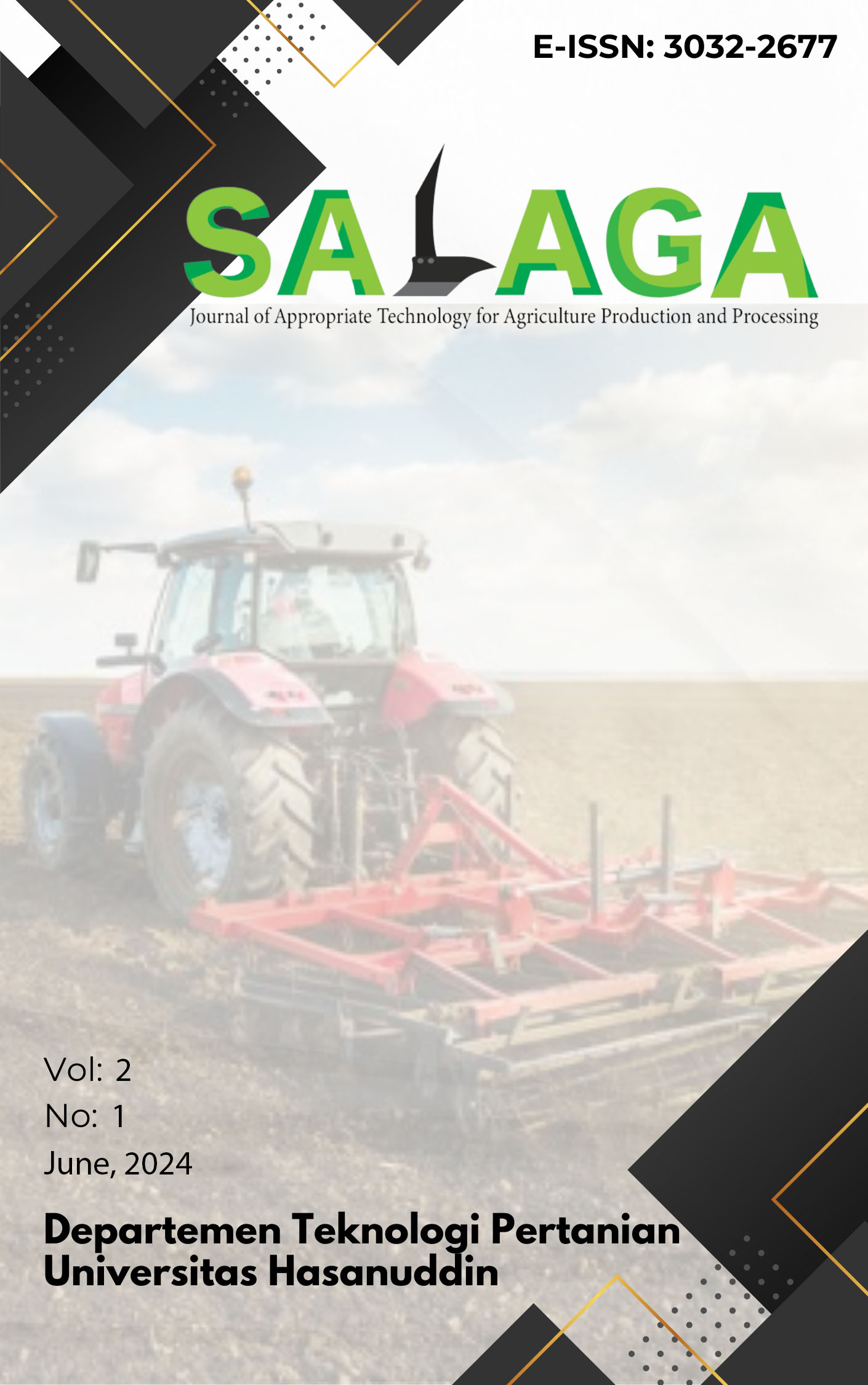Effectiveness of the Application of Drip Irrigation In Some Planting Media for Caisim (Barassica juncea L).
Article Sidebar
Caisim plants are cultivated in highland areas. One of the methods to increase the productivity of caisim is by balancing the amount of water supplied and water needs of the plants. This can be done by applying drip irrigation where water was applied to the plants according to their needs. In addition, setting the appropriare composition of planting medium also needs to be done in increasing the productivity of caisim. This study aims to determine the effect of water application and the composition of several planting media in increasing the growth of caisim using drip irrigation. This research used a completely Randomized Disign (CRD) which consisted of two treatment factos, namely provision of water (A) and planting medium (B). The water supply factor consisted of three treatments, i.e AI (2.49 l/day), A2 (2.69 l/day) and A3 (2.89 l/day). The planting media factors consisted of 3 treatments, i.e B1 (soil + cocopeat 2:1), B2 (soil + husk charcoal 2:1) and B3 (soil + manure 2:1). Research data were analyzed using analysis of variance. In case the analyses results in a significant effect, Duncan's New Multiple Range Test (DNMRT) will be performed. The results of the study showed that the application of water at 2.69 l/day and the use of planting media (soil + cow dung manure 2:1) resulted in the best growth and yield of caisim.
Simangunsong, F. T., Rohanah, A., &; Susanto, E. (2013). Analysis of Drip Irrigation Efficiency and Water Requirements of Mustard Plants (Brassica juncea) on Inceptisol Soil. Journal of Food and Agricultural Engineering, 2(1), 90–95.
Mustawa, M., Abdullah, S. H., Mahardhian, G., &; Putra, D. (2017). Analysis of Drip Irrigation Efficiency on Various Soil Textures for Mustard Plants (Brassica juncea). Scientific Journal of Agricultural Engineering and Biosystems, 5(2), 408–421
Rukmana, R. (2000). Budidaya Tanaman Sayuran. Yogyakarta: Kanisius.
Putri, A. D. (2018). "Nutritional Benefits of Leafy Vegetables in Indonesia." Journal of Agricultural Nutrition, 7(2), 45-58.
Kusmali, M., Munir, A., &; Faridah, S. N. (2015). Application of Drip Irrigation on Red Chili Plants in Enrekang Regency. AgriTechno, 8(2), 140–148.
Pranata, E. (2018). The Influence of the Type of Planting Media and the Provision of Coconut Water on the Growth of Pakcoy Mustard Plants (Brassica rapa L.). University of Muhammadiyah North Sumatra Medan.
Sumarsono, J., Margana, C. C. E., & Mardani, N. (2014). Design and Performance of low fluid pressure drip watering system with constant head for cayenne pepper plants (capsicum frutescens L. on plastic polybags. Scientific Journal of Agricultural Engineering and Biosystems, 2(1), 36–44.
Niapele, S. (2013). Estimation of biomass and carbon stands of dipterocarpa in primary forest ecosystems and LOA (Log Over Area) at PT. Sari Bumi Kusuma (SBK) Central Kalimantan. Agrikan: Journal of Fisheries Agribusiness, 6(1), 29–36. https://doi.org/10.29239/j.agrikan.6.1.29-36
Prastowo. (2010). Development of a Drip Irrigation Design Model for a Sustainable Shallow Groundwater Irrigation System in Nganjuk Regency - East Java. Bogor Agricultural Institute: Bogor.
Sapei, A. (2006). Drip irrigation (2006 Edition). Bogor Agricultural University.
Marlina, E., Anom, E., &; Yoseva, S. (2015). The Effect of Organic NPK Fertilizer on Soybean Growth and Production (Glycine max (L.) Merril). 4(12), 10–14. https://doi.org/10.3969/j.issn.1008-0813.2015.03.002
Muis, A., Sulistyawati &; Arifin, A. Z. (2018). The Effect of Combining NPK Fertilizer and Cow Manure on the Growth and Yield of Sorghum (Sorghum bicolor L.). Journal of Agrotechnology Merdeka Pasuruan. 2(2), 23-130.
Widodo, K. H., & Kusuma, Z. (2018). Effects of Compost on Soul Physical Properties and Growth of Maize on an Inceptisol. Jurnal Tanah Dan Sumberdaya Lahan, 5(2), 959–967.
Nugraheni, F. T., Haryanti, S., &; Prihastanti, E. (2019). Effect of Differences in Planting Depth and Water Volume on Germination and Growth of Sorghum Seeds (Sorghum Bicolor (L.) Moench). Bulletin of Anatomy and Physiology, 3(2), 223–232. https://doi.org/10.14710/baf.3.2.2018.223-232.
Soemartono. 1990. Quantitative Genetics and Molecular Biology. PAU-UGM. Yogyakarta.
Zaenuddin, (2012). Klasifikasi Tanah Dasar teori bagi peneliti tanah dan pelaksaan pertanian di Indonesia. Skripsi Yogyakarta: Gajah Mada University.
Suhardi
Faculty of Agriculture, Hasanuddin University
Indonesia
Haerani
Faculty of Agriculture, Hasanuddin University
Indonesia
Copyright (c) 2024 Muhammad Ikhsan Ali, Suhardi, Haerani

This work is licensed under a Creative Commons Attribution-ShareAlike 4.0 International License.

